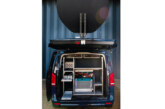CVW teamed up with Rotronics to see how workshops can improve their battery management processes and reduce the financial impact of roadside non-starts.
At this time of year, commercial fleets often fall foul of the increased risk of roadside breakdowns and battery related non-starts. Workshops are inundated with vehicle battery issues. The inevitable fall in temperature significantly affects a battery’s performance and, in extreme temperatures, this can mean as much as a 50% dip.
Coupled with the temperature drop, there are also increased power demands on a vehicle due to the darker nights, which puts excessive strain on the vehicle’s battery, so charging is vital.
Expensive and avoidable non-starts are still, in some quarters, considered to be an acceptable feature in workshop budgets, even though first-class battery testing and charging technology is available. Large sums of money can be wasted because of a lack of battery maintenance, and battery problems remain top of the list of reasons for roadside non-starts.
To gauge the importance that workshops place on battery testing and charging, and how active their battery management practices are, the battery maintenance and service solutions team at Rotronics surveyed more than 40 visitors to the MECHANEX Sandown Park Show in November. Although those surveyed were
a mix of CV workshops and independent garages, the results were indicative of an industry-wide problem.
The findings
95% of those surveyed admitted that they do not have a proactive battery management programme in place at all, while only 5% suggested they try to proactively charge their batteries. 100% of those surveyed told us that they would generally only charge a vehicle when they were unable to get a vehicle started.
Ken Clark, Managing Director of Rotronics, said, “Regular monitoring, testing and charging within a battery management programme, as part of everyday practice in workshops, will considerably reduce avoidable costs and maximise a battery’s performance and lifespan.”
A battery management programme ensures that:

■ Batteries are maintained to optimum levels and avoidable costs are significantly reduced
■ Each workshop is given training and the expertise to maximise fault diagnosis, increase productivity and customer service
■ A full auditable record is available to monitor and track a fleet’s battery performance
■ Batteries are tested pro-actively, at the point of service and routine inspection
■ Imbalanced batteries are identified and charged accordingly
■ Defective batteries are identified and replaced before they affect vehicle reliability
■ Return on investment can be proven
95% of those surveyed admitted they do not test their batteries when receiving them into stock, even though batteries could have been sitting in warehouses for long periods of time. Ken continued, “Without testing the battery, you do not know the real quality of the product that you are buying. Voltage is the key criteria – we know that batteries are often not delivered to the right voltage and this means that you will have a problem before you even fit the battery, as well as accelerating the risk of additional issues developing.
“You run the risk of sulphation and stratification, where the acid level is imbalanced, causing irreversible damage. As a quick measurement, batteries should be received with a minimum of 12.6V and above, and the voltage should not be 10% below their rated capacity on delivery.”
100% of the workshops surveyed advised that they do not know whether the batteries they purchase perform to their correct standard, with 90% only testing batteries if there is a suspected fault with the battery or vehicle. This attitude leaves workshops open to the risk of premature defects and missed opportunities.
80% of the survey group use a conductance type battery tester, but a worrying 20% are still using a traditional load tester (known in the trade as toasters because they heat up the battery and create significant loading, which runs the risk of the battery igniting). Ken said, “Load testers are not an accurate means of testing battery performance. The health and safety issues when using this equipment are a major consideration that shouldn’t be underestimated – let alone the fact that it isn’t an accurate means of testing.”
Balanced charging
65% of the surveyed visitors did not know what the term ‘balanced charging’ meant.
Ken commented, “Battery balancing is a critical factor in keeping commercial vehicles on the road and helping vehicle and fleet owners avoid unnecessary downtime and costs.
“An imbalanced battery is likely to have a reduced lifespan of up to 50%, which results in premature and avoidable early replacement costs. In any 24V vehicle system, having imbalanced batteries – a bit like an irregular heart beat – is a certain route to roadside defects and rising avoidable costs.”
Within six-months of operation, a battery set can be out of balance and, without regular maintenance and checks, fleet owners will see few obvious signs in their vehicles until they experience a road- side non-start or battery failure.
Over time, one battery will have a greater charge acceptance than the other and, in turn, the other battery will be short-changed in the charge process. If this goes on unchecked, without correct maintenance, the deterioration will continue fast.
Ken and his team believe that the impact of battery imbalance and poor maintenance can contribute up to 20% of a workshop’s annual battery-related costs.
Ken concluded, “There is a hefty cost of lost miles and customer dissatisfaction. With some quick maths, we know that a typical operator might have up to 300 non- start defects in any year. A conservative estimate would be £150 for each breakdown, equating to a cost of £45,000. Add the cost of a set of batteries, which can cost up to £300, and we are then looking at a yearly maintenance bill of over £130,000.”










